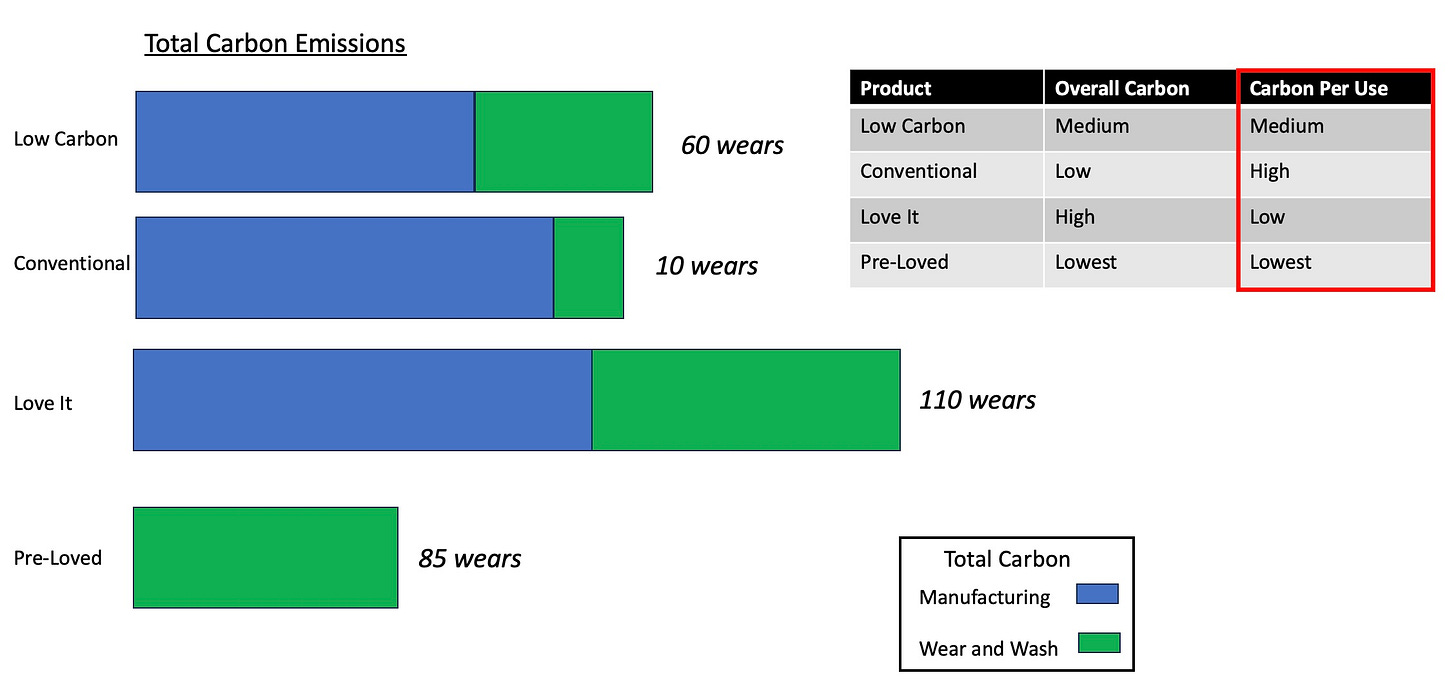Four Tips To Decarbonize Your Wardrobe
Shopping can and should be fun. By following these basic rules, you’ll be able to look great, feel great, and do your part to decarbonize the apparel industry.

Everyday, each of us gets dressed. Our clothes help explain who we are. They also contribute to climate change; the global fashion industry contributes 2-4%1 of global carbon emissions. For the past six months, I've been thinking about how we can continue to wear clothes and decarbonize the apparel industry at the same time. I recently published a brand-focused white paper on the topic that I’d love you to check out.
Instead of summarizing the white paper, today I’m going to explore what each of us can do to help accelerate the transition to a more sustainable apparel industry.
Let’s start with a common challenge: you need a new shirt. When shopping for this new shirt, you encounter four shirt options to choose from:
Low carbon - care went into producing this shirt. The designer sourced sustainable materials, minimized the amount of waste, and worked with low emissions factories. It’s also great looking. You’d wear it 60 times.
Conventional - this shirt is functional. The materials and manufacturing facilities are fine, but they are not the lowest carbon options. The shirt looks good enough to wear, but only when you need to do laundry. You’d wear it 10 times.
Love it - you see it, you love it, you need it. It's a high-quality, durable garment. It's a little pricey, but the price reflects its quality. (While high quality products are not always higher carbon than their conventional alternative, we'll assume that this is the most carbon intensive of the shirts to manufacture.) You’d wear it 110 times.
Pre-Loved - this shirt is in the pre-owned section. It's been worn, but you really like it and can see that it’s high-quality and still has a lot of good life left in it. You’d wear this pre-loved shirt 85 times.
From a carbon perspective, your goal should be to reduce the incremental carbon associated with your outfit everyday. More than 75% of carbon emissions associated with your soon-to-be shirt (and all other apparel products) take place in the supply chain as raw materials are created and transformed into shirts. (Based on the carbon accounting rules, when you buy a pre-loved shirt, there is no associated manufacturing impact, as all of the carbon that went into making the shirt gets allocated to the first owner). The vast majority of non-manufacturing impacts come from washing the shirt.
As a consumer, the two ways to reduce your incremental emissions per wear are to
buy products that with relatively low emissions from manufacturing and/or
wear each shirt more often, which allocates those manufacturing emissions across more uses AND reduces the number of shirts you need in your closest to meet your goal of getting dressed everyday.
Based on all of this, the lowest carbon option is the Pre-Loved shirt, followed by Love It, even though the latter has the most carbon associated with its manufacture. For those who are more visual, here’s an illustrative graphic:
Now imagine that you return to that same store in search of a pair of pants for your child, who happens to be growing like a weed. The potential lifetime of those pants will be limited, because your kid will quickly outgrow them. The total potential number of wears (the green bar above) isn’t all that big, because kids can't wear the same pair of pants for a decade even if they want to (though some try to). This means that your best bet is to look for ways to buy pants with the lowest impacts from manufacturing (the blue bar above). The best ways to do this are to seek out hand-me-downs, purchase used items, limit the amount you purchase, and buy low carbon options when purchasing new clothes.
Regardless of who you’re shopping for, here are four things to remember when trying to reduce your footprint:
Buy Better to Buy Less: There are few things more wasteful than a closet full of clothes that you don't like and rarely wear. When buying clothes, be intentional. Having fewer things that stand the test of time can make you look and feel better while lowering your carbon footprint. If possible, buy used versions of great products.
Trade-in Your Clothes When Possible, Donate When Not, Recycle as a Last Resort: Those clothes at the back of your closest likely still have wears in them. If the brand you bought from has a resale business, trade it back to the brand. While you may receive a gift card, the real reason to engage with the brand directly is that doing so will increase the brand’s inventory of sellable used products. The more used products brands receive and sell, the fewer new products they have to manufacture to hit their growth rates. This could lead brands to shift their business models from selling new products to making great products that they can sell or rent multiple times and in multiple ways (for more on the dynamics behind this, read the white paper).
Seek Out Sustainable Options: Because the majority of impacts come from manufacturing products, buying clothes from brands that are actively decarbonizing their supply chains is always a great decision.
Staples can be Simple: No one wants to buy my used undershirt or socks. For products that aren't likely to have a second life, seek out low carbon AND easy to recycle options. A 100% cotton shirt that can be recycled is way better option than a material blend that cannot be easily recycled today.
Shopping can and should be fun. By following these basic rules, you’ll be able to look great, feel great, and do your part to decarbonize the apparel industry.
See https://apparelimpact.org/wp-content/uploads/2023/06/Aii_RoadmapReport-615-1.pdf and https://www.mckinsey.com/industries/retail/our-insights/fashion-on-climate


